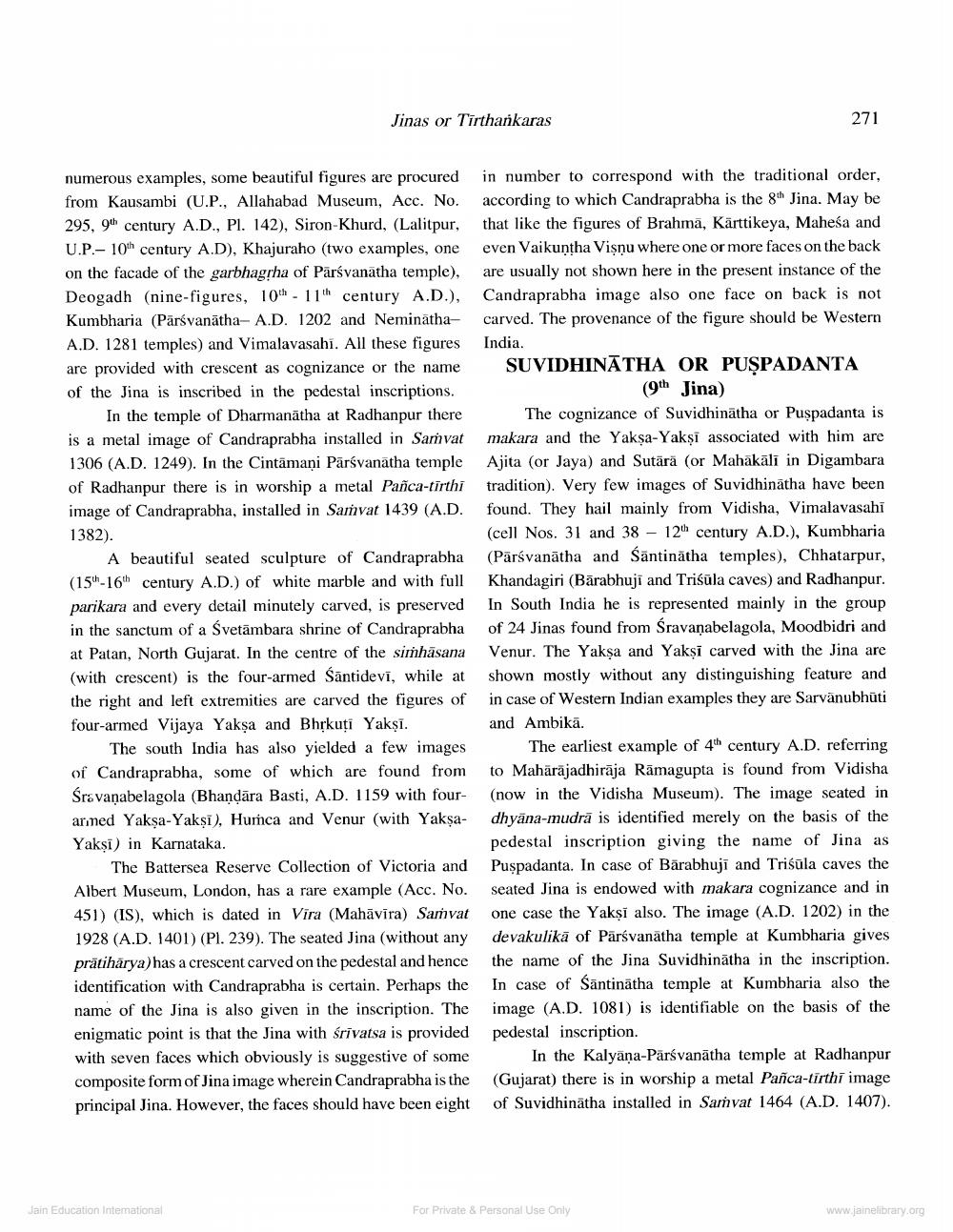________________
Jinas or Tirthankaras
numerous examples, some beautiful figures are procured from Kausambi (U.P., Allahabad Museum, Acc. No. 295, 9th century A.D., Pl. 142), Siron-Khurd, (Lalitpur, U.P. 10th century A.D), Khajuraho (two examples, one on the facade of the garbhagṛha of Parsvanatha temple), Deogadh (nine-figures, 10th 11th century A.D.), Kumbharia (Pärsvanatha- A.D. 1202 and NeminathaA.D. 1281 temples) and Vimalavasahi. All these figures are provided with crescent as cognizance or the name of the Jina is inscribed in the pedestal inscriptions.
In the temple of Dharmanatha at Radhanpur there is a metal image of Candraprabha installed in Samvat 1306 (A.D. 1249). In the Cintamani Pārsvanatha temple of Radhanpur there is in worship a metal Pañca-tirthi image of Candraprabha, installed in Samvat 1439 (A.D. 1382).
A beautiful seated sculpture of Candraprabha (15th-16th century A.D.) of white marble and with full parikara and every detail minutely carved, is preserved in the sanctum of a Svetambara shrine of Candraprabha at Patan, North Gujarat. In the centre of the simhasana (with crescent) is the four-armed Śantidevī, while at the right and left extremities are carved the figures of four-armed Vijaya Yakṣa and Bhṛkuți Yakṣi.
The south India has also yielded a few images of Candraprabha, some of which are found from Śravanabelagola (Bhandara Basti, A.D. 1159 with fourarmed Yakṣa-Yakṣi), Humca and Venur (with YakṣaYakşi) in Karnataka.
The Battersea Reserve Collection of Victoria and Albert Museum, London, has a rare example (Acc. No. 451) (IS), which is dated in Vira (Mahāvīra) Samvat 1928 (A.D. 1401) (Pl. 239). The seated Jina (without any prätiharya) has a crescent carved on the pedestal and hence identification with Candraprabha is certain. Perhaps the name of the Jina is also given in the inscription. The enigmatic point is that the Jina with śrīvatsa is provided with seven faces which obviously is suggestive of some composite form of Jina image wherein Candraprabha is the principal Jina. However, the faces should have been eight
Jain Education International
271
in number to correspond with the traditional order, according to which Candraprabha is the 8th Jina. May be that like the figures of Brahma, Kārttikeya, Mahesa and even Vaikuntha Visņu where one or more faces on the back are usually not shown here in the present instance of the Candraprabha image also one face on back is not carved. The provenance of the figure should be Western India.
SUVIDHINATHA OR PUSPADANTA (9th Jina)
The cognizance of Suvidhinatha or Puspadanta is makara and the Yakṣa-Yakṣi associated with him are Ajita (or Jaya) and Sutärä (or Mahakali in Digambara tradition). Very few images of Suvidhinatha have been found. They hail mainly from Vidisha, Vimalavasahi (cell Nos. 31 and 38 12th century A.D.), Kumbharia (Pārsvanatha and Śantinatha temples), Chhatarpur, Khandagiri (Bārabhuji and Triśūla caves) and Radhanpur. In South India he is represented mainly in the group of 24 Jinas found from Śravanabelagola, Moodbidri and Venur. The Yakşṣa and Yakşi carved with the Jina are shown mostly without any distinguishing feature and in case of Western Indian examples they are Sarvanubhuti and Ambikā.
The earliest example of 4th century A.D. referring to Mahārājadhiraja Rāmagupta is found from Vidisha (now in the Vidisha Museum). The image seated in dhyana-mudra is identified merely on the basis of the pedestal inscription giving the name of Jina as Puspadanta. In case of Barabhuji and Trisula caves the seated Jina is endowed with makara cognizance and in one case the Yakṣi also. The image (A.D. 1202) in the devakulikā of Pārsvanatha temple at Kumbharia gives the name of the Jina Suvidhinatha in the inscription. In case of Śantinatha temple at Kumbharia also the image (A.D. 1081) is identifiable on the basis of the pedestal inscription.
In the Kalyana-Parsvanatha temple at Radhanpur (Gujarat) there is in worship a metal Pañca-tīrthī image of Suvidhinatha installed in Samvat 1464 (A.D. 1407).
For Private & Personal Use Only
www.jainelibrary.org




